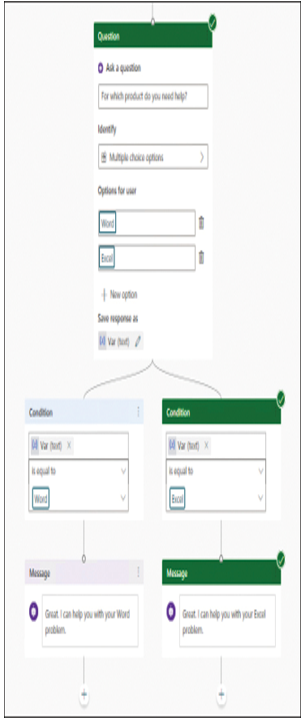Skill 6.1: Describe Power Virtual Agents capabilities
Chatbots have long been seen as a useful and economical means of providing customer service, but the development process involved in creating them was often lengthy and troublesome. This was, in large part, because of the constant communication required between the development and customer service departments, both prior to and subsequent to the deployment of the bot. Power Virtual Agents, by virtue of its no-code or low-code development requirements, allows the customer service personnel themselves to create chatbots and update them as needed when circumstances change.
This skill covers how to:
■ Describe use cases for Power Virtual Agents
■ Describe where you can publish chatbots
■ Describe topics, entities, and actions
Describe use cases for Power Virtual Agents
Customer service and first-tier technical support services are always expensive propositions. This cost can be particularly galling for organizations when so many of the customer issues are simple and repetitive that it does not seem worth paying live representatives to give the same answers over and over. Live support can also be frustrating to customers when they discover that the hours they can interact with a live person are limited or that they must wait in a queue for the next available representative.
Chatbots were created to take over these repetitive and time-consuming tasks from live telephone and chat personnel. A bot with a script designed to provide basic information to customers can answer the simple questions at any time of the day or night, leaving the more complicated issues to the live representatives.
Citizen developers
As time has passed and the value of chatbots has been recognized by more organizations, the bots have been enhanced to take on more complex tasks themselves, even using artificial intelligence (AI) to perform actions instead of just supplying information. One of the main problems with these increasingly complex chatbots is that they require an extensive development effort.
In a chatbot development project, a gap has always existed between the people who know what tasks the bot has to perform and those who know how to make the bot do them. This gap is particularly problematic for organizations in which the customer service and technical support requirements change frequently. One of the primary design objectives for Power Virtual Agents, as with the other Power Platform tools, is to reduce that gap by making it possible for the customer service and technical support people to function as citizen developers by creating and updating the chatbots themselves.
Power Virtual Agents provides a guided graphical development environment that allows these citizen developers to create chatbots by specifying the questions most commonly asked by customers and then supplying possible answers to the questions. This strategy allows the bot to lead the customers through a branching dialog, such as that shown in Figure 6-1, which leads them to a satisfactory answer to their question.

FIGURE 6-1 A branching dialog in a Power Virtual Agents chatbot
The Power Virtual Agents development interface allows the personnel familiar with customers’ questions to program the bot with appropriate responses that they themselves would otherwise supply. More important, when the questions change or new questions arise, these same people can modify the bot to accommodate the organization’s changing needs. In other environments, updating a bot can require a lengthy period of latency as the software goes back to a developer for changes to the code, retesting, and redeployment.

